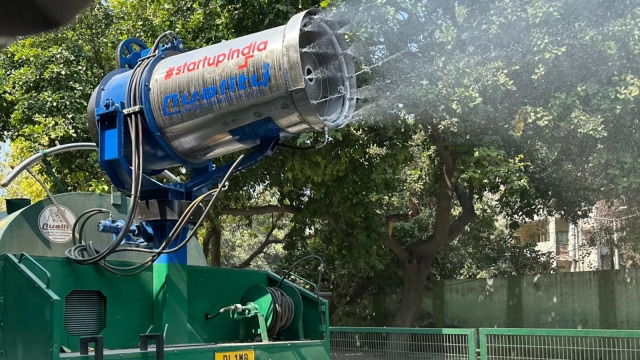Delhi air quality again in ‘Poor’ category, Mundka records AQI of 374
The average AQI in the capital on Friday was 292, only eight points away from touching the red colour-coded category (very poor).
 A smog gun sprays on Delhi roads to combat the air pollution.
A smog gun sprays on Delhi roads to combat the air pollution. The Central Pollution Control Board (CPCB) reported that Delhi’s air quality index (AQI) was in the ‘poor’ category (279) on Saturday afternoon.
Seven areas in the national capital reported ‘very poor’ air quality. Mundka recorded an AQI of 374, followed by Bawana (367), Wazirpur (354), Jahangirpuri (346), Dwarka (332), Narela (328), and Rohini (328). Five stations reported ‘poor’ air quality, including Okhla (298), Vivek Vihar (294), Punjabi Bagh (286), R K Puram (271), and Ashok Vihar (266).
The average AQI in the capital on Friday was 292, only eight points away from touching the red colour-coded category (very poor).
The Commission on Air Quality Management (CAQM) in the National Capital Region and adjoining areas had Tuesday invoked Stage 1 of the Graded Response Action Plan (GRAP) after the AQI dropped significantly in the capital post-Dussehra celebrations.
According to the forecast by the Indian Institute of Tropical Meteorology, the AQI may worsen further and cross the 300 mark to enter the ‘very poor’ category by Sunday.
The forecast also said the contribution of stubble burning to the deterioration of air quality in the national capital may increase in the coming days.
A total of 2,643 stubble-burning events – 1,348 in Punjab, 627 in Haryana, 657 in Uttar Pradesh, and 11 in Delhi – were detected between September 15 and October 18, said the Indian Agricultural Research Institute.
It added that 135 stubble-burning cases were observed in these states on Friday alone.
However, the Decision Support System (DSS), which identifies the local sources of air pollution in Delhi, Friday showed that stubble burning contributed just one per cent to the city’s air pollution.
The major pollutant Saturday noon was found to be Particulate Matter (PM) 10 in nine pollution hotspots with levels five times higher than the prescribed standard and PM 2.5 being the major pollutant in four hotspots.












